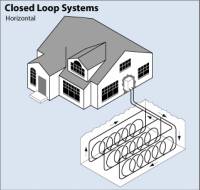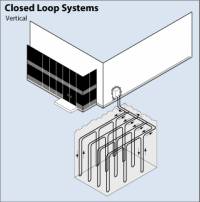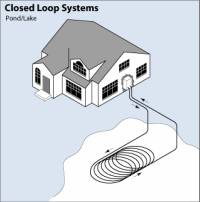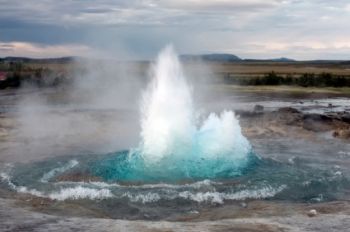|
Geothermal Energy
Geothermal energy refers to using the energy in the earth’s crust for heating and cooling purposes. There are two main systems I’ll talk about. I’ll cover geothermal heat pumps here and Geothermal Power Generation on a separate page. Geothermal heat pumps take advantage of the fact that at about ten feet of depth, the temperature of the ground stays between 50 and 60 degrees year round. This is true in the summer when the air temperature is 80 as well as in the winter when the air temperature is 5. Obviously 55 degrees is a lot closer to the temperature we’d like to keep our homes at than the air temperatures I just mentioned. Heat pumps move heat from the ground to help warm a home in the winter and transfer heat from the home to the ground in the summer to help cool it. There are several ways this can be done, but the basic principle is the same: if you pass a liquid through a buried pipe, its temperature will equalize with the surrounding soil. Horizontal Array Heat Pumps
The most common systems pump fluid through long lengths of buried piping. If there is a lot of land available, the pipe is laid horizontally in trenches or an excavated bed. Sometimes the piping will be coiled to give allow a greater length to be conveniently laid is a smaller area. The total length of piping needed depends on the size of the home. These systems are easiest to install during new construction, but they can be installed in older homes if the home owner is willing to put up with major excavation on their land. Vertical Array Heat Pumps
If less land is available, a vertical arrangement is used. In a vertical array, the installers drill a series of holes to a depth of 150-400 feet. Then they place a u-shaped pipe in each hole. They often fill the holes with material that transfers heat better than the native soil. The u-shaped loops are connected at the surface and fluid is pumped through in the same fashion as a horizontal arrangement. Although it varies greatly with local conditions, vertical installations usually are more expensive because of the drilling involved. Pond and Lake Heat Pumps
Although most heat pump systems are installed in the ground, if a home is close to a pond or lake, a closed loop system can be sunk to the bottom. This avoids the expense and disruption of digging. Even though it's in water, this is still a geothermal energy system. Closed Loop Systems and Heat ExchangersMost systems are closed loop. That is they cycle fluid (usually an antifreeze mixture) through a sealed system. Inside the home, the fluid passes through a heat exchanger that passes heat energy between the fluid and the home. The exchanger can be fluid-to-air, air-to-air or a combination. Fluid to air exchanges pass the energy from the circulating system to air. In essence it pre-warms the air so less energy is needed from a furnace to heat the home. Fluid to fluid exchangers pass heat from the closed loop system to a hot water heating system in the home. Heat pumps are especially well suited for radiant floor heating because these systems operate at lower temperatures than baseboard or radiator hot water systems. An advantage of a fluid-to-fluid system is that it can be designed to cool the home in the summer in addition to warming it in the winter. Hybrid systems combine both fluid-to-air and fluid-to-fluid exchange. Heat pumps do require electricity to run the pumps. However the amount of that energy is small compared to the amount of heat extracted from the earth. Overall, you can keep your home comfortable using a lot less energy with a geothermal heat pump as part of your system. Geothermal energy systems are quite reliable. The buried components generally carry guarantees of 25-50 years but expectation is that they’ll perform much longer without trouble. The in-home heat exchanger is reliable and requires little maintenance. Even though their trouble-free, you should have the system checked once a year to keep it operating at maximal efficiency. In summary, if you're building a new home, you may want to seriously consider using gathering geothermal energy via a heat pump as part of your home heating system. The initial cost will be higher, but at today's energy costs, you can expect to recoup your initial investment in 5-10 years because of lower energy costs. LinksClick here to return to Alternative Energy Home from Geothermal Energy |
